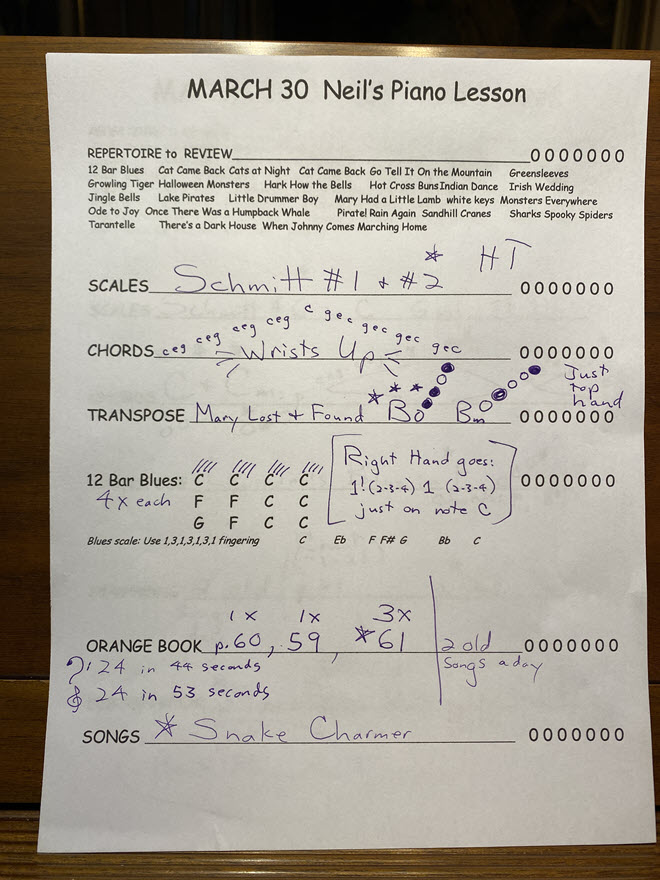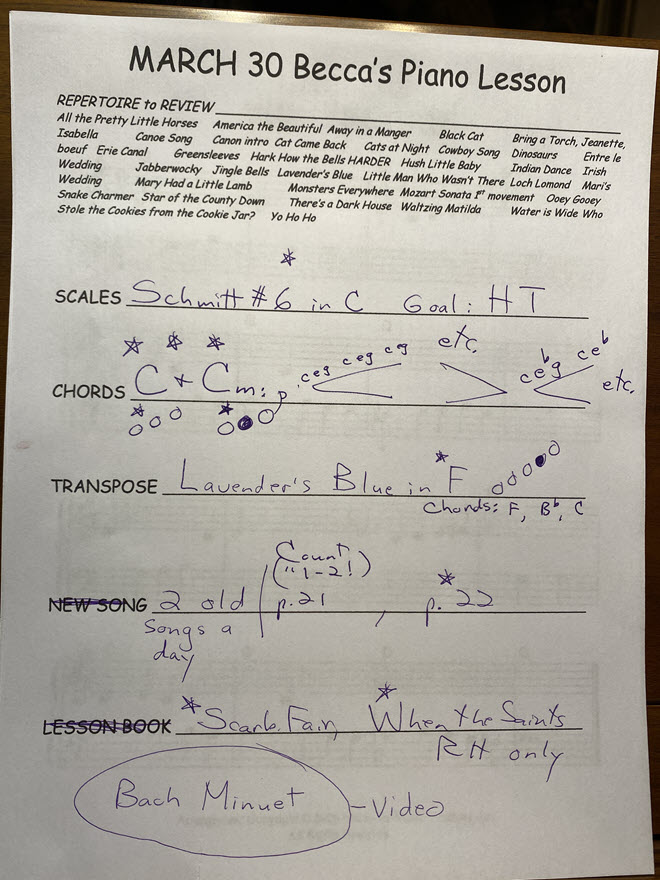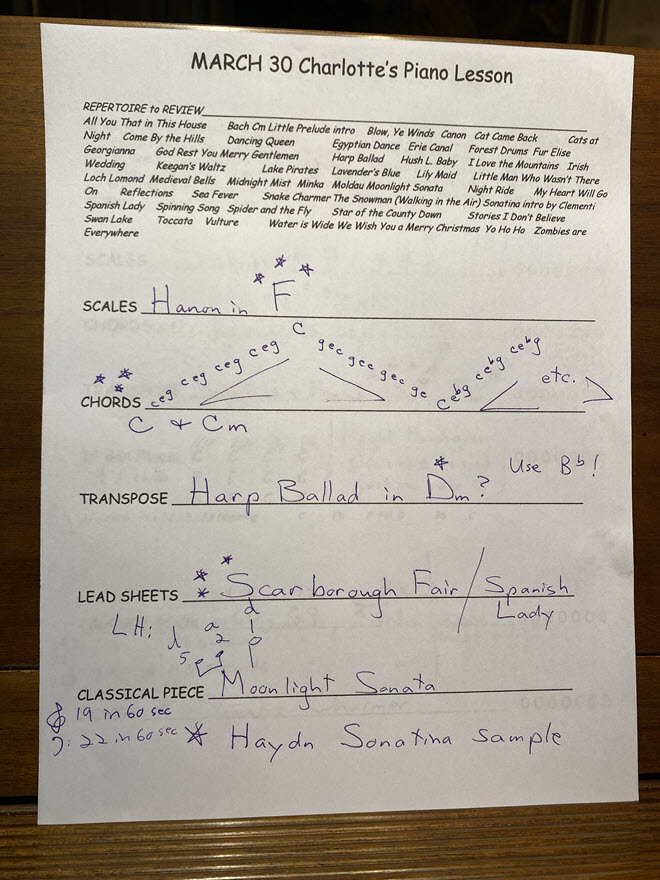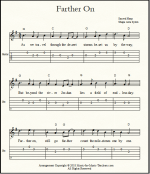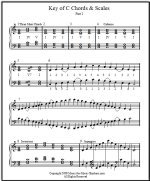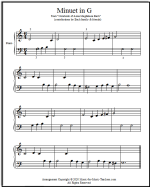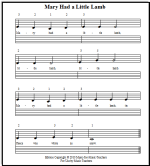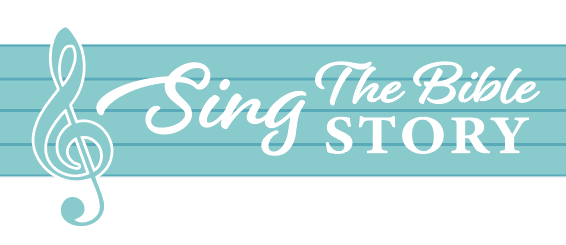Social Distance Teaching -
How a Music Teacher Fared
Virtual teaching - maintaining a "social distance"- has NEVER been this music teacher's desire, but it is my goal to gain success at it now!
This page is going to be my journal...
Day One of Social Distance in the World of Music Teaching:
TODAY WAS AWFUL!
I discovered there is a time delay when I speak, sing, or play, and when my student hears/speaks/sings/plays! My husband, the electronics technician, calls this "latency." All I know is that it made things very awkward. Lots of stopping and repeating.
ZOOM, Skype, or FaceTime to bridge the distance?
I tried ZOOM, and I tried FaceTime. Neither were entirely dependable. And with both, my students and I were out of synch.
I quickly discovered that I couldn't play scales - or anything else - along with my students. And if I tried to sing as they played, I could not hear them. Frequently, I would see their fingers moving on the screen, but there would be no sound.
Singing music with an echo...
A voice lesson was the worst. My student and I could not even warm up together. In an attempt to synchronize our voices, I asked her to sing in unison with me "One, two, three, four... One, two, three, four..." That was the ultimate test. It was as if she was trying to be my echo. I could not accompany her on the piano as she sang.
When in doubt, teachers SHOUT
To make up for the difficulty in communicating, my voice rose, and ROSE. After a bit I realized I might be shouting at the phone (as I often do when chatting on speaker phone), and one of my students kindly said that it wasn't necessary for me to be so loud, and that she could hear me just fine.
Poor connections, social distancing
A few times, the connection was broken. I switched from ZOOM on my laptop to FaceTime on the phone with two of my students. No better. This is Alaska, after all, and our connectivity is just not entirely bulletproof.
Arghh, what a day.
WAS THIS GOING TO BE MY FUTURE???
At least I'm saving some paper and ink on music printing
One thing I was thankful for was this source of free sheet music online that I could send parents links to print at home.
Day Two of Social Distancing for Music Teachers
First thing this morning, my husband chased around town for over an hour, looking to get me a better wireless router, as well as an ethernet cable extender/joiner thingy, so I could double the length of my ethernet cable and have my internet "hardwired" to my computer. The wifi for the phone, the hardwire for the laptop. I was going to experiment today and see which one was more successful.
It turned out to be a much easier day.
I had already subconsciously begun to change my expectations, and with it, my teaching approach.
I would LISTEN, then demonstrate, then have them perform again, then demonstrate again. Instead of simultaneous performance, it would be a back-and-forth affair.
This worked fairly well.
There was still a bit of "latency" or non-synchronization -
- but it wasn't bothering my students. Just me! I made timid attempts to play along, softly, with my students, and while not being very successful, the delay wasn't bothersome. Even my one voice lesson today, using FaceTime, was tolerable.
Not loud enough for me
But the kids' phones or computers are a bit too quiet. I'm going to see if they can turn them up.
Struggling to connect a ZOOM laptop session with one student and her mother, we jumped over to our iPhones briefly - and found that using BOTH simultaneously was actually a better approach!
I could zero in on the piano keys, using a phone
I do have a little mechanical "arm" that can hold my phone high over the keys if I want, but then I have to detach the phone again so I can see the student's closeups - and there WERE a few closeups of her hands that I wanted to see. Not a flexible enough arrangement.
One thing I hadn't expected...
...but I was very much touched by, was the amount of support from parents. Many of them stayed right beside their child's piano bench and either held or continually adjusted the phone or laptop (or both, in the case of one student), for a whole half hour. It was gratifying to me to see that kind of willingness, and time commitment.
I'm thinking of recommending the phone + laptop for tomorrow's lessons...
Day 3 of Musical Social Distancing
Teaching this way requires lots of ahead-of-time preparation. What do I mean?
Lesson sheets must be printed and on the piano, ready to write on...
When I do make notes on their lesson sheet, I have been moving my iPhone up to the sheet to show students what I'm drawing or writing... or contrariwise, moving the sheet over to my laptop's camera, to show them on Zoom what I'm writing.
Sheet music on my end, sheet music on their end
I need to have musical choices - new sheet music - pre-printed and RIGHT THERE on the piano - no hunting around! and email the pdf links to parents to print ahead of the lesson.
My habit of finding new music for my students "just in time!" won't fly here, for I have to get the music to parents BEFORE THE LESSON and trust that they have a printer at home!
Video options for social distancing
I suggested the dual approach today: ZOOM on the laptop, plus a video call on the phone. Hah! With everyone today, it was a flop. There was interference - as in LOUD UNPLEASANT SQUEALING - on their end, though not mine. Probably because my computer is hardwired to the internet, not using wireless.
Not everyone can do FaceTime, of course, so I suggested Google Duo for those with a different kind of phone... another free app. So far, everyone who wants to use their phone instead of Zoom on a laptop seems to have an iPhone.
Unexpected bonuses of Distance Music Teaching
Two of my students, a brother and sister, sit WAY TOO CLOSE to the piano at home! At my studio, I have them adjust their distance by holding their fists up to the fallboard on my piano, at arms' length.
I discovered that at home, their piano lid is quite different than mine, and that in order to touch the wood of the piano with their fists, they angle their arms high above the keys, instead of parallel to the keys. So they are aiming up where the sheet music rests.
Posture Problems
Another student LIFTED A SHOULDER again and again when playing the left hand chords of Irish Wedding - never before had I noticed that phenomenon! I always sit on the right side, not the left side, of students.
Dear me... I guess I ought to be walking all around my students to be checking for posture errors!
Parents are Alerted
When something caught my attention, such as the lifted shoulder and the too-close-to-the-piano situation, I was able to quickly give a holler for the mom and point it out to her. (So far it's been all moms all the time.)
And I've also been able to quickly give kudos and congratulate parents for some praise-worthy skill I just saw demonstrated, such as a soft touch in just the right spot.
A Way for Sick Students to Take Lessons
If people become comfortable with this approach, then I foresee fewer sick absences.
Frequently, a parent calls and says, "Susie's got the sniffles/sore throat/you-name-it this week, so I'm thinking that we should all just skip lessons today..."
But unless a kid is confined to bed, I'm thinking that there is no reason they couldn't do some "distance learning."
DAY 4 of Distance Teaching
MY FIRST FLOP.
But I am not surprised - it was this child's SECOND piano lesson, and she is very young. SIX. I don't even recommend beginning piano lessons until 7 or 8, unless a child is highly motivated.
So, this girl had not learned yet even how to TALK to me... you know how it is with new, shy children. And I wouldn't expect it, actually, for weeks. She wouldn't look me in the eye, Lesson One, live! So even less, Lesson Two, distance!
NO CONCENTRATION, AND FIGHTING HER MOM
When I realized that she was struggling with "Mary Had a Little Lamb" on the black keys, despite having conquered "Hot Cross Buns" and "Pizza Please," I knew it was a NO-GO.
That was almost 20 minutes into the lesson, after doing easy things like locating "D" for me all up and down the piano, saying the musical alphabet forwards and backwards 3 times as fast as she could, and identifying her finger numbers for me, playing a couple songs from the Just the Black Keys book.
Hand Grabbing
Her poor mother was trying to help her by correctly locating her hands... usually a fatal move on the part of parents!
This little girl didn't like it any better than you or I would like someone grabbing our hands - though I know we do it as teachers! - so a lot of squirming and tossing of hair began.
RECOGNIZING WHEN YOU'RE NOT MAKING PROGRESS
Finally, I intervened. "Kylie (not her real name)," I said, "we're done now. I'd like to talk to your mom."
She and I had a discussion about the limitations of distance teaching for such a YOUNG brand-new beginner, and I told her that when the "craziness" of this time is over, I will credit her for this lesson!
This poor young mom, who just acquired a digital keyboard for her daughter, lost her job last week. Like a lot of people everywhere...
RECOVERING OVER THE WEEKEND AFTER WEEK ONE OF DISTANCE MUSIC TEACHING
Well, well! I found a page at "Clavier Companion" that has a nice collection of encouraging tips for "Teaching in the Time of COVID19"!
Among other things, they have a 10-tip page on using ZOOM well...
Get this: if you want to play a duet with your student, mute them, count off, and begin. They will hear you, but the time lag will not be there! I AM SKEPTICAL, but I must try this...
REMEMBERING SUCCESSES of the week before!
Building on previous work, especially scales and broken chords and transposing of a well-known piece, is pretty sure-fire.
Included in "scales" at my studio currently are my Basic Scales of both kinds, Schmitt pages 1, 2, & 3, and Hanon exercises.
When my students are working on Schmitt and Hanon, they learn them well enough to transpose from C to D, E, F, G, A, and B. If they have sufficient ability and are amenable (I will give them the choice), they will also do Db, Eb, Gb, Ab, and Bb as well.
TRANSPOSING MUSIC
One reason transposing songs is such a success, and so helpful when teaching by distance, is because I always choose a song the student already knows VERY WELL - and I give them a choice. Ode to Joy? or Canoe Song? They get to decide.
Then, their already-learned skill of finding "Tonic, whole, whole, half, whole" steps to make a major pentatonic scale comes into play, along with their "ear."
My students find that the easiest song to transpose is Mary Had a Little Lamb... but by moving finger 3 of the melody one half step to the left, we also change it to minor (calling the two versions "Mary Lost and Found," as in "Mary lost her little lamb, little lamb, etc. It ran away from home."
Then we change the sound to a happy tonality again: "Mary FOUND her little lamb, little lamb, little lamb, Mary found her little lamb, etc: It came back home again!" Yes, DEATHLESS lyrics.
What makes a good transposing song?
A piece they know very well, with a limited range of notes, and no black keys to start off, is a good candidate for transposing. Then, if they LIKE the piece, even better!
"Ode to Joy," "Snake Charmer," and "Indian Dance" are all logical choices for transposing, because they are only 5 or 6 notes.
A couple of my students are transposing "Lavender's Blue," using open 5th chords in the left hand, and finding it to be very pretty. Two of my older students are transposing Harp Ballad, which is musically rewarding - each new position is freshly beautiful, with its own set of intricacies.
With this technique in your tool belt...
your students will be working on technique, musicianship, and theory all with one exercise!
WEEK 2, DAY 1 OF
TEACHING MUSIC BY ZOOM
Confutatis! Maledictis!
This morning seems like FOREVER AGO. Another day filled with rushing, but also valuable new perceptions.
FLASHCARDS TO THE RESCUE
It has become a fun game to test the kids against my little blue box timer, with which they are already acquainted. In one minute, how many of the 24 cards can they name?
For the littlest ones, the treble clef cards are just Middle C, D, and E; the bass clef cards are Middle C and B.
I need to sort my many flashcards into different sets of different numbers and reading ability, and keep them rubber-banded up and ready to go with each different student.
Routines that we can build upon make it a lot easier to control the lesson remotely.
USING STAFF PAPER
My preferred method of writing notes onto paper with students is to start from scratch, with each of us drawing 5 parallel lines for each needed staff.
That did NOT work today, computer screen to computer screen! At least not for the youngest of my beginners.
Next time, I'm going to have parents print off staff paper of an appropriate size for my student, and I'll have the same at my end. We ARE able to hold things up to the computer screen (where the camera is located) and see the other end well enough, but saving time and explanations are important, so I'm going to have pre-made staff paper from now on.
BREAKS IN-BETWEEN STUDENTS
Fifteen minutes seems almost long enough. I needed to adjust my attitude after each lesson and before the next one - not to mention needing to get a glass of water, and perhaps visit the bathroom!
I'm still finding myself texting parents at the last minute to print out one music sheet or another. And they are doing it without complaint, bless their hearts.
THE NAP WAS HEAVENLY
Being able to close my eyes for 20 minutes, even though my mind was still racing, was a wonderful break. Feet up, eyes closed, deep breaths.
After that refresher, I felt ready for the next session of possibly needing to yell some more into the computer!
WEEK 2, DAY 2 of Over-the-Computer Distance Teaching
Today I feel like I am hitting my stride. Laaaaaaaa!
But it only is happening because I stayed up last night until my eyes crossed,
- finishing printing out student sheets (as references for myself, and to send them photos after the lessons are over)
- texting sheet music pdf links to parents!
The importance of a written record
I don't think I've mentioned how crucial these student lesson sheets are to me. The students take them home, but I have a record of them for later.
It is so easy to forget what the kids are doing, and a lot of them are doing the SAME THINGS, but are perhaps at different skill levels.
Here are some examples of my students' lesson sheets on Monday of this week:
I've started putting the date up in the header, since I am keeping the sheet at my studio, and every sheet looks almost exactly the same as the student's sheet from the week before.
Ordinarily I enjoy using all colors of ink on my students' sheets, contrasting with the black, but I noticed last week that pink and turquoise blue were not photographing well! Very important for my students to be able to see my scribbling!
Having an established printed routine to plug new comments or assignments into sure helps me save time!
With voice, there have been changes in how I teach
It has been very interesting to see what has evolved between me and my voice students.
The piano now plays a very small role, since there is a synchronization issue - we can't perform together by distance without a time "lag" or difference.
So instead there is an emphasis on "listen, then imitate". I sing a phrase, then they copy me. Over and over. Tone quality, breath support, articulation are all focused on! I am seeing how the piano can get in the way of focusing on the student, covering up the student's weaknesses instead of being a support.
Make THEM play the melody
For those students who have the ability to play their melody line (my students are all 18 or younger), I now also have them play along with themselves part of the time, rather than only listen to my end playing the melody. I never did this much before, because it is time-consuming.
I have a teenager with a pretty voice, who has pitch-matching problems, but I gave her "Break Now My Heart and Die" recently, which is a fairly tricky melody, and playing the melody for herself is the only way she can learn some of those intervals.
That probably seems pretty obvious to you voice specialists, but though I've stressed this in the past, I've never taken lots of time to just listen to a student struggle through a hard section with the piano over and over until they really GOT that line.
Less music, but more focus
There are other innovations I've gradually worked into with my voice students that are BENEFITING them, such as making them sing, a capella, their warmup routines for me ... HAHAHAHA... quite revealing! Though this is not fun for them, I have taken a weird pleasure in making my students go through their vocalises that are at the top of their lesson pages.. I know this is improving their boldness, and their singing!
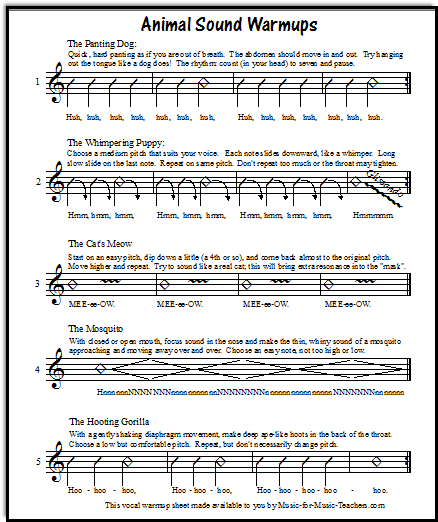
I would never have thought of doing this, if there had not been this inability to accompany them on the piano as they sing.
It has been fascinating to watch this.
Dianna:
Your website is a light in the darkness. THANK YOU for all you do in helping to spread the love of music. It matters!
Recent Articles
-
Moonlight Sonata in Cm
Hello! Thank you for sharing the introduction to Beethoven's Moonlight Sonata in C minor! It will be a good trial for a certain student. Can you make -
Farther On, a Beautiful Shape-Note Hymn: vocal ensemble & instruments
Farther On is a beautiful Shape-Note hymn in the Sacred Harp tradition. Download this free hymn sheet music for ensemble, guitar, piano, & lead sheet. -
12 Major Scales Free Download for Piano: Chords, Arpeggios & Scales
12 major scales & chords: free, printable downloads. One & two-octave scales, I, IV & V chords & inversions & arpeggios, & a new PART 2! -
Bach Minuet in G Piano Music: Arrangements for All Levels
The Bach Minuet in G is a famous piece that kids enjoy playing - now with six arrangements, all of your students can conquer this piece. -
Mary Had a Little Lamb for Beginner Piano: Learn How to Add Chords
There is so much you can do with Mary Had a Little Lamb! As piano music for kids, it is unbeatable for showing them how to use chords.
Interested in songs from the Bible for your students or church? Check out my other website, SingTheBibleStory.com!
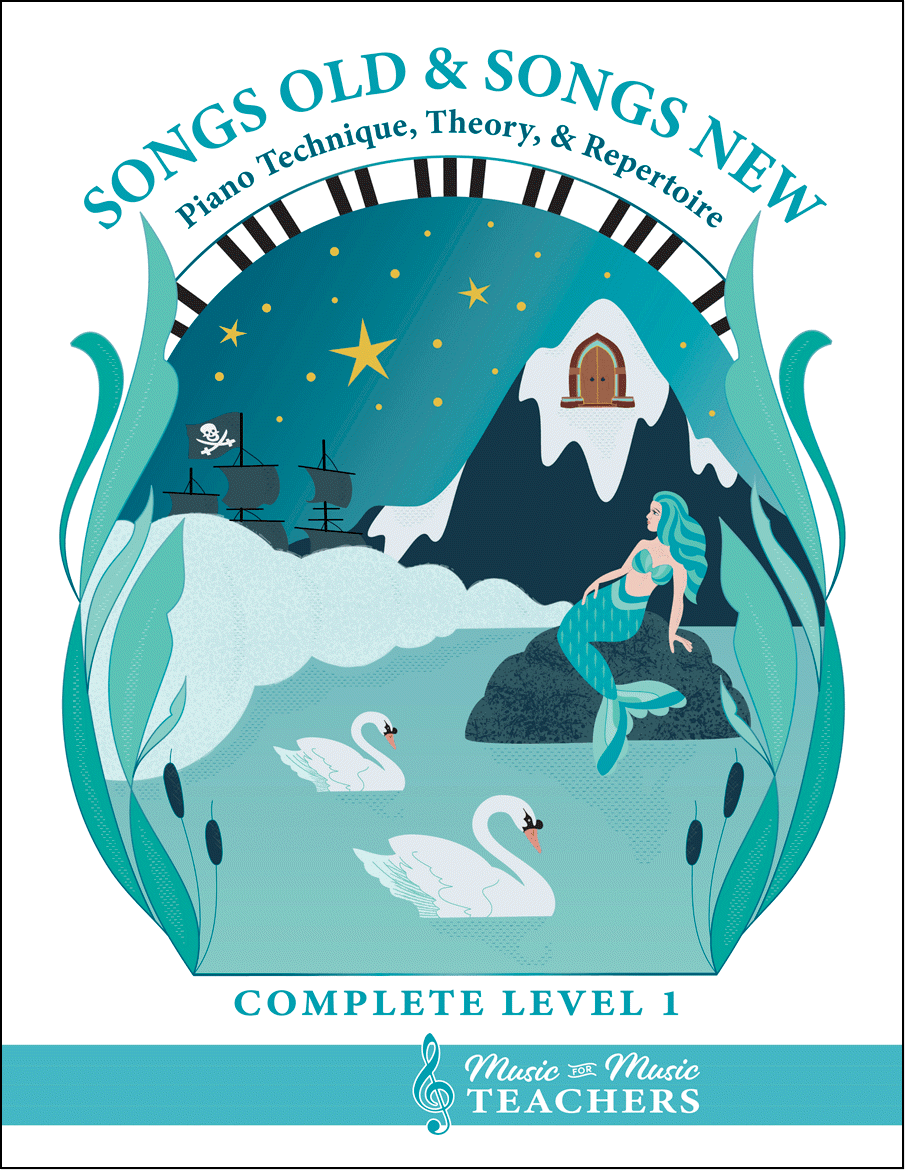
All the first-year material I give my beginner students.
Piano keyboard sheets, scales, chords, note-reading exercises, and over 256 pages of music!
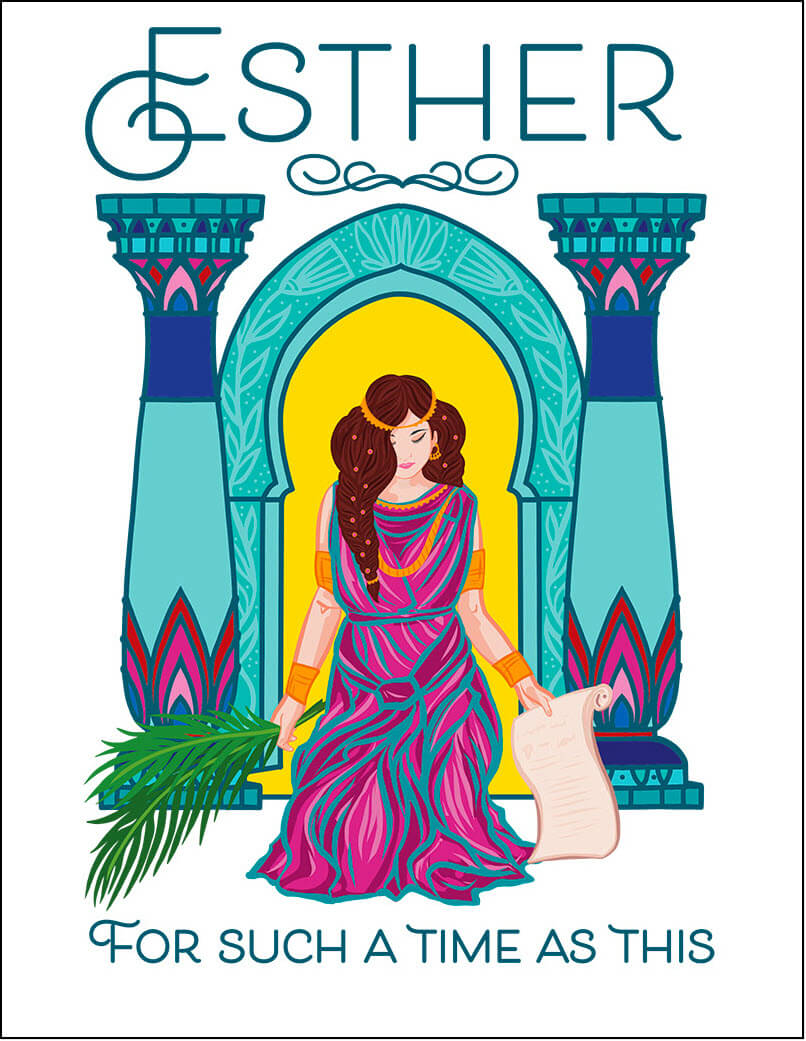
This beautiful song book for piano & voice "Esther, For Such a Time as This", available as a digital download, tells the riveting story of the time when Jews in ancient Persia faced a foe named Haman, and how a brave young queen risked her life to save her people.
A good choice for a singing story-teller, an operatic group, a short theater production, or a class of children!
This book is also available from Amazon as a paperback.
This book is available as a digital download from this site. Visit this page to see some free examples from the book.
It is also available from Amazon as a paperback!
This is the perfect easy start for little pianists.
And when they start reading white-key notes on the staff, this is a fun easy resource to say each week, "Choose a new black-key song at home this week and figure it out to show me next lesson!" They will be spending more time at the piano.
A perfect read aloud storybook
for little boys or girls.
The Adventures of Tonsta highlight the travels of a very young boy with a good heart, who goes about helping folk in trouble.
With a red cap on his head and a sack of tools slung over his shoulder, Tonsta seems to meet people in distress wherever he goes.
Lots of trolls in this book - including one who gives him a Christmas gift!
About the Author

Hi, I'm Dana! (Say that like "Anna".) I'm the owner of Music-for-Music-Teachers.com, and a newer site, SingTheBibleStory.com.
Like some of you, I've been playing the piano since early childhood, and have added a few other instruments along the way, plus an interest in arranging and composing music.
You can find out more about me and the reason for this website at my About Me page.
